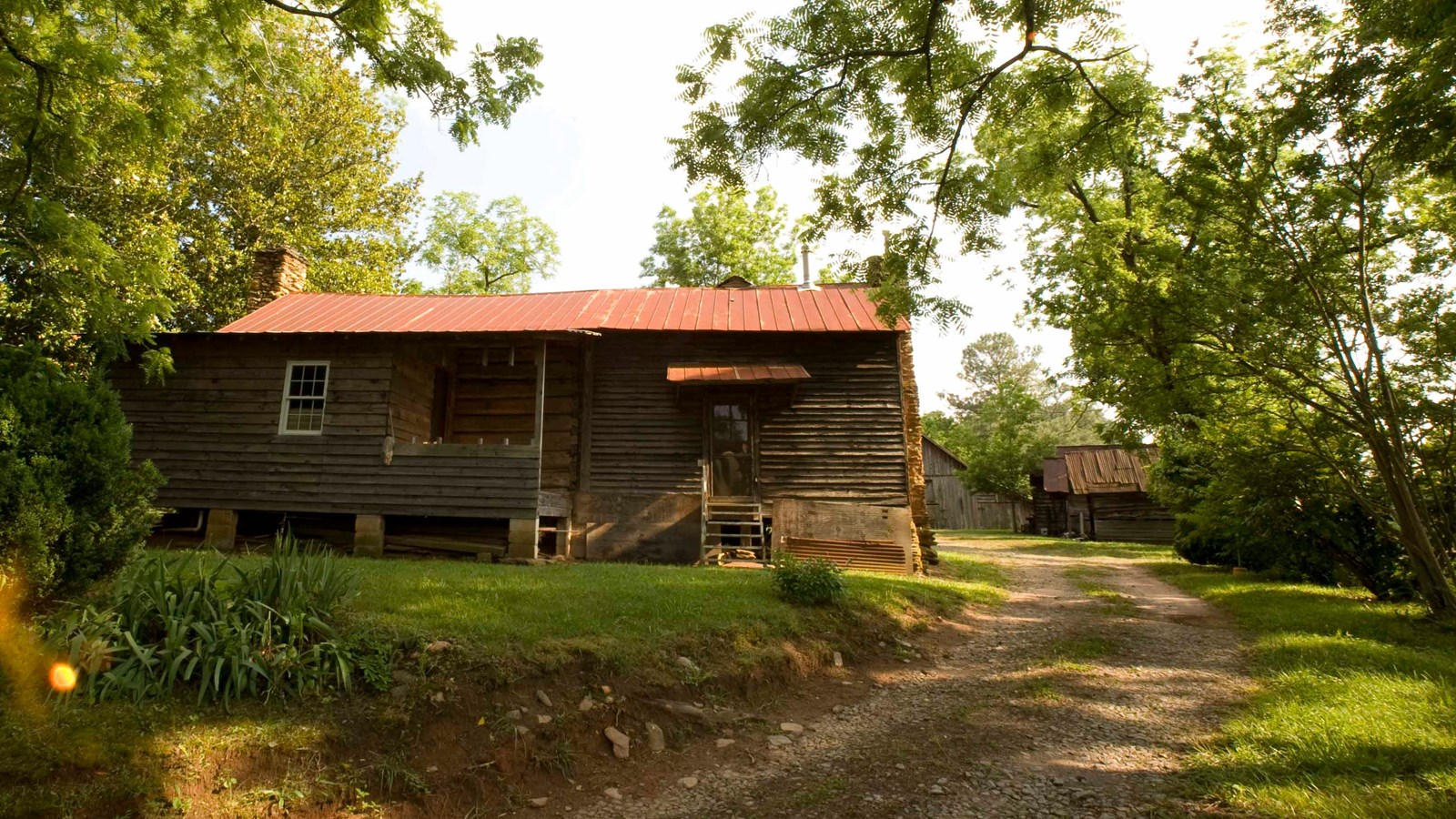Last updated: January 26, 2021
Place
Hyde Farm

NPS/Robert Armstrong
Parking - Auto, Parking - Bus/RV, Restroom, Scenic View/Photo Spot, Toilet - Flush, Trailhead, Trash/Litter Receptacles, Water - Drinking/Potable
Located on the northwest bank of the Chattahoochee River and near Johnson Ferry lies Hyde Farm. Originally known as Cherokee Indian territory, Hyde Farm was settled by James Cooper Power in the 1830s. Other American Indian villages were located just upstream from the farm, but those villagers were forced to leave as well during the Trail of Tears. The original log cabin still exists within the Hyde farmhouse. This is the land that eventually became Hyde Farm. However, farmers borrowed American Indian farming traditions to grow their crops which included such things as sweet potatoes, pumpkins, squash, and beans.
James Cooper Power was the son of Joseph and Isabella Power. Joseph and Isabella had four children: Mary Elizabeth, James Cooper, George Abner, and Pinkney Joesph. The Power children all got married and decided to establish farms near their parents along what is now Hyde Road. During this time small family farms predominated the piedmont areas; nuclear families worked the land; housing ranged from crude log cabins to substantial frame, brick, or stone houses; farm families manufactured many necessities. The Power family, including children, worked on the farm tirelessly until 1874.
Beginning in 1874 during cotton-picking time, James Cooper Power sharecropped with James Alexander Hyde, a Civil War Confederate veteran moving from South Carolina to Alabama. (During this time many people travelled by foot and stayed in various cities contracted to sharecrop along their journey.) Hyde and his family moved to the Mt. Bethel community east of Cobb County where they had four children, one of which was Jesse Clifford Hyde (who was born just 2 miles from the Power cabin in 1881). James Hyde and Jim” Power’s relationship, though based on work but founded on friendship, was a unique and wholesome commitment to each other. It was a connection and collaboration that grew and flourished over the next 25 years.
The South had been devastated by the Civil War; planters had ample land but little money for wages or taxes. The solution was to use the sharecropping system that focused on families working together to farm, which generated cash for the croppers, landowners, merchants and the tax collector. Poor white farmers, who previously had done little farming, needed cash as well and became sharecroppers. In essence, the sharecropper “rented” the land that he/she farmed and gave a portion of his crop back to the landowner as payment.
James Power died in 1901 and the Hyde’s continued to work on the farm thereafter. James Hyde’s son, Jesse, was one of the farmers and a construction worker as well. After the bank foreclosed on the property, Jesse was able to obtain the title of the Powers homestead (Hyde Farm) in 1920, which encompassed 135 acres of land. Jesse and his family then moved to the farm from Paulding County. Jesse and his wife, Lela, raised six children; Buck, J.C., Maglee, Gladys, and Rosalee at the farm. Up until his death in 1972, Jesse Hyde continued his father’s work tending to the farm. Leaving the farm to his bachelor sons, J.C. and Buck sustained the up-keep of the farm with traditional methods; using tools like the mule-drawn plows for power, crude wooden plows, all sowing by hand, cultivating by hoe. As east Cobb County developed and suburbanized in the mid-1960, the Hyde brothers began selling fresh vegetables and other produce items off the back of their truck, in the parking lot of Bethel Methodist Church at the intersection of Power’s Ferry and Lower Roswell Roads. Overtime Buck and J.C. Hyde became very famous for their fresh vegetables.
Buck Hyde died in 1991. Inheritance taxes forced J.C. Hyde to sell 40 acres of the farm’s bottom land the next year, but he negotiated with the Trust for Public Land to insure that 95 acres of the property would be become part of the Chattahoochee River National Service Area. Currently, Hyde Farm is a total of 135 acres; 95 acres is jointly owned and managed by the National Park Service and Cobb County, the other 40 acres continues to be property of the Trust for Public Land. The 135 acres of land consists of forest, fields, and several streams. The buildings of the farm were built from circa 1830 to 1950. Hyde Farm is in an important area of the Chattahoochee watershed (Mulberry Creek) which provides drinking water for the City of Atlanta and surrounding areas. Developing this land could seriously affect the quality of the water in the Chattahoochee. Hyde Farm has acres of and provides wildlife habitat to fox, coyote, deer, songbirds, beaver, and other species whose habitat has been destroyed by development.
Hyde Farm landscape is characterized by sloping terrain with cultivated fields along the plateau southwest and north of the house. There are nine outbuildings connected with the house; the barn, corncrib, machine shop/garage, gear house, shuck shed, two chicken houses, and the well house. Hyde Farm is potentially eligible to the National Register because it is a well preserved foundational display of small farms established in the late 19th and early 20th century.
